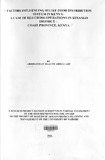| dc.description.abstract | This study was on Factors Influencing Relief Food Distribution System in Kenya, Case of Red Cross Operation in Kinango District, Coast Province, Samburu Division. Kenya Food Security Steering Group assessments indicated that food security situation has declined substantially in some districts and an estimated 1.38 million people in rural areas were highly food insecure following poor long rains of 2008 in most arid and semi arid areas of the country such as Kinango.
The study involved extensive research on relief food distribution systems and influencing factors. This led to the use of various data collection techniques such as questionnaires, interviews and observation methods. Stratified sampling method proved advantageous because of the population size of the beneficiaries. A total of 40 respondents were selected from a population of 100. The data collected the was coded, analysed and presented informs of tables.
This study revealed that there were shortcomings in the Relief food distribution system in Samburu division of Kinango district. It has further revealed that there was lack of participatory role of the community in engaging more actively in decision making processes and implementation of the relief food distribution program. It was learnt that there was great expectations from the residents of Samburu from the Kenya Red Cross Society in regards to the food assistance.
The study also revealed that the lack of proper planning, implementation, monitoring and evaluation strategies in food distribution activities in Samburu and in the larger Kinango resulted in little impact on school enrolment and improvement of food security. This is evidenced by the poverty levels of Kinango district and level of relief dependence. Open dialogue and regular consultations was established as the key to effective relief food distribution system in the area.
Further research could be carried out to establish why aid agencies are continuing with relief food distribution even when they are aware of the dependence syndrome factor that comes as a result of relief food. A research could also be undertaken to investigate why food insecurity cannot be addressed in a sustainable manner, yet Kinango district has vast natural resources such as rivers that can be used for modem irrigation to improve livelihood and reduce dependency. The impact of appropriate Monitoring and Evaluation methods in food distribution system could also be researched further. | en_US |

